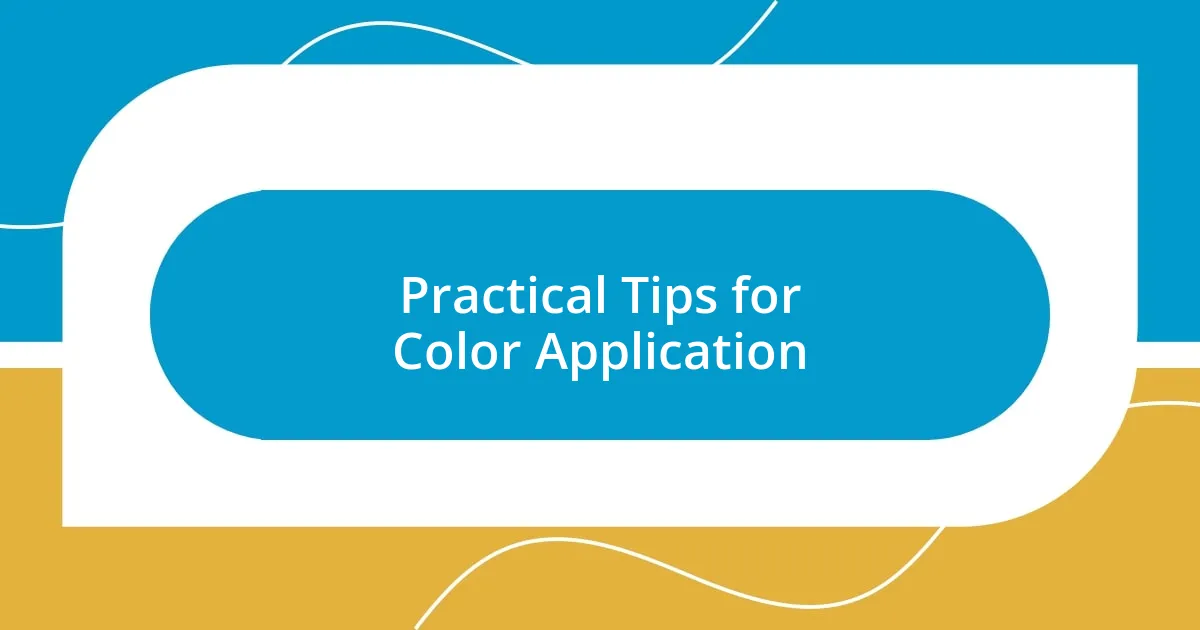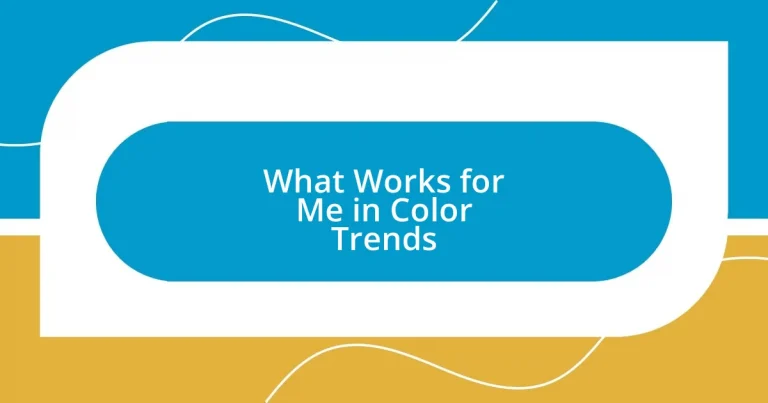Key takeaways:
- Color trends reflect societal changes and personal experiences, affecting emotions and perceptions in spaces.
- Key considerations for choosing colors include mood, lighting, functionality, and personal preference.
- Combining colors effectively requires balance between harmony and contrast, and the use of patterns can enhance décor.
- Future trends may focus on muted, nature-inspired colors and vibrant hues that symbolize resilience and hope.

Understanding Color Trends
Color trends can feel almost magical, don’t you think? They capture the mood of a moment and can evoke feelings ranging from serenity to excitement. I still remember when teal burst onto the scene; it felt like a breath of fresh air in a world dominated by beiges and browns.
What I find particularly fascinating is how color trends often reflect societal changes. For instance, during times of uncertainty, we might gravitate towards calming colors like soft blues and greens. I recall repainting my living room in a soothing lavender during a particularly stressful period, and the change truly transformed my space into a sanctuary.
When trying to understand color trends, consider personal experiences and cultural contexts. Have you ever noticed how certain colors in fashion come alive during specific seasons? I remember when mustard yellow became popular in autumn—suddenly, sweaters and accessories in that hue popped up everywhere! It brought a warm and cozy vibe that felt just right for those crisp fall days.

Choosing Colors for Your Space
Choosing the right colors for your space can feel like crafting a unique story. I recall when I painted my home office a rich navy blue; it instantly created an aura of sophistication and focus. The color enveloped me as I worked, making even mundane tasks feel more inspiring. Colors can define how we interact with our environment, and it’s essential to think about the emotions you want to evoke in each room.
Here are some key considerations when choosing colors for your space:
- Mood: Think about how the colors make you feel. For example, warm tones like reds and oranges energize while cooler shades like greens promote tranquility.
- Lighting: Observe how natural and artificial light changes the color throughout the day. I once picked a vibrant yellow that looked dull in the evening light; learning from that experience taught me to test colors first!
- Functionality: Consider the purpose of each room. A calming palette in a bedroom helps with relaxation, while bright accents in a kitchen can inspire creativity.
- Personal Preference: Stay true to your taste! I’ve noticed that mixing colors I love, even unconventional ones, creates a space that feels uniquely mine.

Psychology of Color Choices
When we dive into the psychology of color choices, it’s fascinating to see how colors can manipulate our emotions and perceptions. For example, the color red often stimulates feelings of passion and urgency, which is why it’s commonly used in sales and marketing. I remember attending a high-energy event where the decor was predominantly red; it truly invigorated the atmosphere and kept everyone buzzing with excitement!
On the other hand, colors like blue and green are often associated with calmness and tranquility. I once painted my meditation space a soft, mint green. The moment I walked in, I felt enveloped by a wave of peace; it was as if the color itself was whispering to my mind to unwind and breathe.
Furthermore, there’s an emotional connection to colors influenced by personal experiences. For instance, yellow reminds me of sunshine and childhood summers spent outside. It not only brightens my mood but also sparks nostalgia, making it a staple in my art projects. Isn’t it amazing how the colors we choose can resonate with our past, helping us shape our current environment in meaningful ways?
| Color | Psychological Impact |
|---|---|
| Red | Stimulates passion, urgency |
| Blue | Promotes calmness, security |
| Green | Encourages tranquility, balance |
| Yellow | Evokes happiness, nostalgia |

Combining Colors Effectively
I find that the key to combining colors effectively lies in understanding the balance between harmony and contrast. For instance, I once experimented with pairing a soft lavender with a deep charcoal gray. It created a unique vibe that felt both soothing and sophisticated. Have you ever tried mixing pastels with dark, bold shades? The resulting tension can make a space feel dynamic and alive.
When it comes to accent colors, I’ve discovered that they can truly breathe life into a room. A few years back, I added vibrant orange pillows to a neutral beige sofa. The change was instant—suddenly, the space felt warm and inviting. This experience taught me how a small burst of color can transform an entire atmosphere.
Lastly, don’t shy away from patterns when combining colors. I remember a time when I paired a geometric patterned rug with solid blue walls. The contrast not only added interest but also tied the room together beautifully. How do you feel about mixing patterns? It might seem daunting, but I assure you that embracing that challenge can lead to delightful surprises in your décor choices.

Current Popular Color Palettes
Current color trends reflect a vibrant blend of colors that resonate with various moods and styles. Right now, earthy tones like terracotta and olive green are gaining traction, often evoking feelings of warmth and connection to nature. I recently redecorated my home office with rich, earthy colors, and it truly feels like a sanctuary where creativity can flourish. Have you ever noticed how certain colors can instantly transport you to a certain place or memory?
Another popular palette includes soft pastels, especially blush pink and light peach, which create a gentle, inviting atmosphere. I vividly recall visiting a friend’s cafe adorned in these subtle hues; it felt like a warm hug that made me want to linger over coffee and enjoy conversation. The calming effect of such colors can significantly alter the ambiance of a space.
Lastly, the trend of bold jewel tones like emerald green and sapphire blue is captivating many design enthusiasts. I tried incorporating a deep sapphire rug into my living room, and the moment it was laid down, it transformed the entire space—the richness of the color added depth and luxury. Have you experimented with jewel tones? They not only make a statement but also provide a perfect backdrop to highlight other design elements, making a room feel both opulent and inviting.

Practical Tips for Color Application
When applying color, I’ve found that testing samples in your space is crucial. I remember the time I painted a small section of my wall with a bold turquoise. At first glance, it felt overwhelming, but once it dried in natural light, it settled beautifully into the room. Have you ever been surprised by how a color can change with different lighting? It’s like meeting a new friend in various environments—it can completely change your perspective.
In terms of application techniques, I love using a sponge or stippling brush for texture. One weekend, I experimented with a soft gold using a sponge on a feature wall, and it added an elegant shimmer that instantly elevated the atmosphere. It made me think: how often do we overlook the power of texture in color application? Sometimes, a simple technique can transform a flat color into something extraordinary.
Lastly, don’t forget the power of timing. I’ve learned that starting my painting projects in the early morning, when the light is fresh, gives me a better sense of how colors will look throughout the day. One afternoon, I started painting at dusk, and I regretted it when the final color appeared drastically different under the night sky. How do you plan your projects? Timing can make a significant difference in achieving the perfect look.

Future Color Trend Predictions
Looking ahead, I sense that muted, almost nostalgic colors will take center stage in future trends. There’s something soothing about shades like dusty rose and muted ash blue that evoke a sense of calmness in our busy lives. Just the other day, I stumbled upon a textile collection featuring these tones, and I felt an instant rush of comfort—like wrapping up in a soft blanket on a chilly evening. Don’t you think we all crave that sense of peace in our environments?
As sustainability continues to influence design choices, I predict we’ll see more colors inspired by nature, like soft greens and warm terracottas, becoming mainstream. I remember visiting a botanical garden, and the delicate hues of the leaves and soil left a lasting impression on me. They seemed to whisper stories of authenticity and connection. Do you feel that nature has a way of grounding us? That’s precisely the beauty I believe we’ll carry into our color palettes.
Looking further, I can’t help but envision a resurgence of vibrant, playful hues as a symbol of resilience and hope in the face of challenges. The energy I felt when I decorated with bright yellows and deep oranges was infectious. It was like bringing a slice of summer indoors, reminding me of sunny days and joyful moments. What will it take for you to embrace bolder colors? I think the key lies in finding those moments that spark joy and daring to bring them into our spaces.














